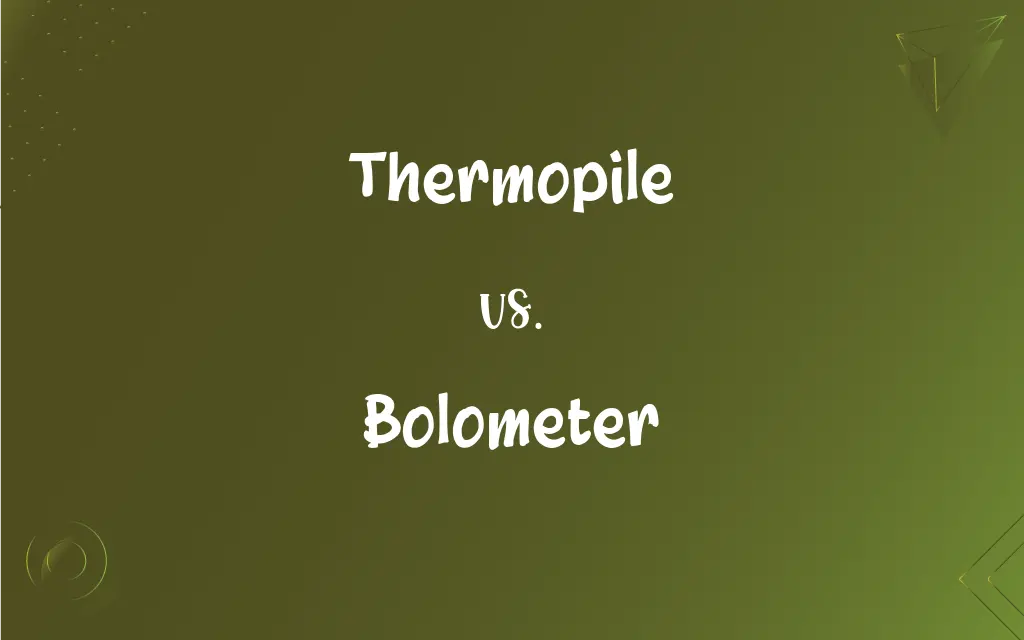Thermopile vs. Bolometer: What's the Difference?
By Janet White & Aimie Carlson || Updated on May 22, 2024
A thermopile converts thermal energy into electrical energy using multiple thermocouples, while a bolometer measures electromagnetic radiation by detecting changes in temperature.

Key Differences
A thermopile consists of multiple thermocouples connected in series or parallel to generate a voltage output proportional to the temperature difference between its junctions. It is commonly used in infrared thermometers, gas leak detectors, and heat flux sensors. A bolometer, on the other hand, measures the power of incident electromagnetic radiation by detecting the resultant change in temperature of an absorbing element. The element's temperature rise is proportional to the power of the absorbed radiation.
Thermopiles generate an electrical signal directly from the heat difference they detect, making them useful in direct temperature measurement applications. In contrast, bolometers rely on temperature-sensitive resistance changes to measure radiation power, making them suitable for sensitive radiation detection.
Thermopiles are typically more robust and simpler to use, as they do not require a separate power source for their operation, whereas bolometers often require a cooling mechanism to maintain sensitivity and accuracy.
Comparison Chart
Definition
Device converting thermal energy to electrical energy
Device measuring electromagnetic radiation via temperature changes
Composition
Multiple thermocouples connected in series/parallel
Absorbing element with temperature-sensitive resistance
ADVERTISEMENT
Output
Voltage proportional to temperature difference
Temperature rise proportional to radiation power
Common Uses
Infrared thermometers, gas leak detectors
Astronomy, infrared spectroscopy, radiometry
Power Source
No external power source required
Often requires cooling mechanism for sensitivity
Sensitivity
Detects small temperature differences
Measures power of incident radiation
Thermopile and Bolometer Definitions
Thermopile
Device converting heat into electrical energy.
The infrared thermometer uses a thermopile to measure temperature.
ADVERTISEMENT
Bolometer
Uses an absorbing element with temperature-sensitive resistance.
A bolometer's resistance changes with the absorbed radiation's power.
Thermopile
Generates voltage without an external power source.
The thermopile sensor works by generating a voltage from the heat it detects.
Bolometer
Device measuring electromagnetic radiation through temperature changes.
The bolometer detected faint cosmic microwave background radiation.
Thermopile
Consists of multiple thermocouples.
A thermopile's output voltage increases with the number of thermocouples.
Bolometer
Measures radiation power accurately.
Bolometers are used in radiometry to measure the power of incident radiation.
Thermopile
Common in non-contact temperature sensing.
Thermopiles are ideal for non-contact infrared thermometers.
Bolometer
Sensitive to various radiation types, including infrared.
Bolometers are essential in infrared spectroscopy for radiation measurement.
Thermopile
Measures temperature differences accurately.
Thermopiles are used in gas leak detectors for precise temperature measurement.
Bolometer
Often requires cooling for accuracy.
The bolometer's cooling system ensures precise measurement in astronomy.
Thermopile
A device consisting of a number of thermocouples connected in series or parallel, used for measuring temperature or generating current.
Bolometer
An instrument that measures radiant energy by correlating the radiation-induced change in electrical resistance of a blackened metal foil with the amount of radiation absorbed.
Thermopile
(electronics) An electronic device that converts thermal energy into electrical energy. Usually constructed using a series-combination of thermocouples
Bolometer
(physics) A sensitive device for detecting and measuring the energy of electromagnetic radiation.
Thermopile
An instrument of extreme sensibility, used to determine slight differences and degrees of heat. It is composed of alternate bars of antimony and bismuth, or any two metals having different capacities for the conduction of heat, connected with an astatic galvanometer, which is very sensibly affected by the electric current induced in the system of bars when exposed even to the feeblest degrees of heat.
Bolometer
An instrument for measuring minute quantities of radiant heat, especially in different parts of the spectrum; - called also actinic balance, thermic balance.
Thermopile
A kind of thermometer for measuring heat radiation; consists of several thermocouple junctions in series
Bolometer
An instrument that measures heat radiation; extremely sensitive
FAQs
What is a thermopile?
A thermopile is a device that converts thermal energy into electrical energy using multiple thermocouples.
What are common uses of thermopiles?
Thermopiles are used in infrared thermometers, gas leak detectors, and heat flux sensors.
How does a bolometer work?
A bolometer detects the power of incident radiation by measuring the resultant temperature rise in an absorbing element.
What is a bolometer?
A bolometer is a device that measures electromagnetic radiation by detecting temperature changes in an absorbing element.
Do thermopiles need an external power source?
No, thermopiles do not require an external power source to generate a voltage.
What type of output does a thermopile generate?
A thermopile generates a voltage output.
What are common uses of bolometers?
Bolometers are used in astronomy, infrared spectroscopy, and radiometry.
What type of output does a bolometer generate?
A bolometer measures a temperature rise proportional to the absorbed radiation power.
How does a thermopile work?
A thermopile generates a voltage output proportional to the temperature difference between its junctions.
Do bolometers need cooling?
Yes, bolometers often require a cooling mechanism to maintain sensitivity and accuracy.
Which device measures temperature differences?
Thermopiles measure temperature differences.
Which device measures radiation power?
Bolometers measure the power of incident radiation.
Are bolometers sensitive to different types of radiation?
Yes, bolometers are sensitive to various types of electromagnetic radiation.
Can bolometers detect cosmic radiation?
Yes, bolometers are used in astronomy to detect faint cosmic radiation.
Are bolometers used in infrared applications?
Yes, bolometers are widely used in infrared applications like spectroscopy.
Are thermopiles used in non-contact temperature sensing?
Yes, thermopiles are commonly used in non-contact temperature sensing applications.
What is the main advantage of using a thermopile?
Thermopiles provide accurate temperature measurement without needing an external power source.
Can thermopiles be used in gas detection?
Yes, thermopiles are used in gas leak detectors for accurate temperature measurements.
Can thermopiles detect small temperature differences?
Yes, thermopiles are designed to detect small temperature differences accurately.
What is the main advantage of using a bolometer?
Bolometers offer precise measurement of radiation power.
About Author
Written by
Janet WhiteJanet White has been an esteemed writer and blogger for Difference Wiki. Holding a Master's degree in Science and Medical Journalism from the prestigious Boston University, she has consistently demonstrated her expertise and passion for her field. When she's not immersed in her work, Janet relishes her time exercising, delving into a good book, and cherishing moments with friends and family.
Co-written by
Aimie CarlsonAimie Carlson, holding a master's degree in English literature, is a fervent English language enthusiast. She lends her writing talents to Difference Wiki, a prominent website that specializes in comparisons, offering readers insightful analyses that both captivate and inform.































































